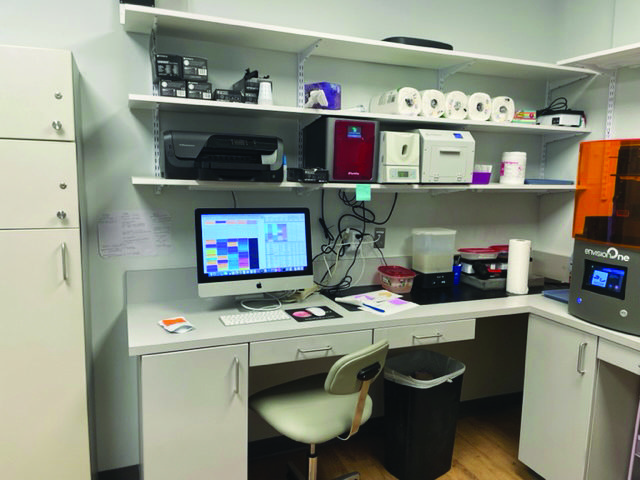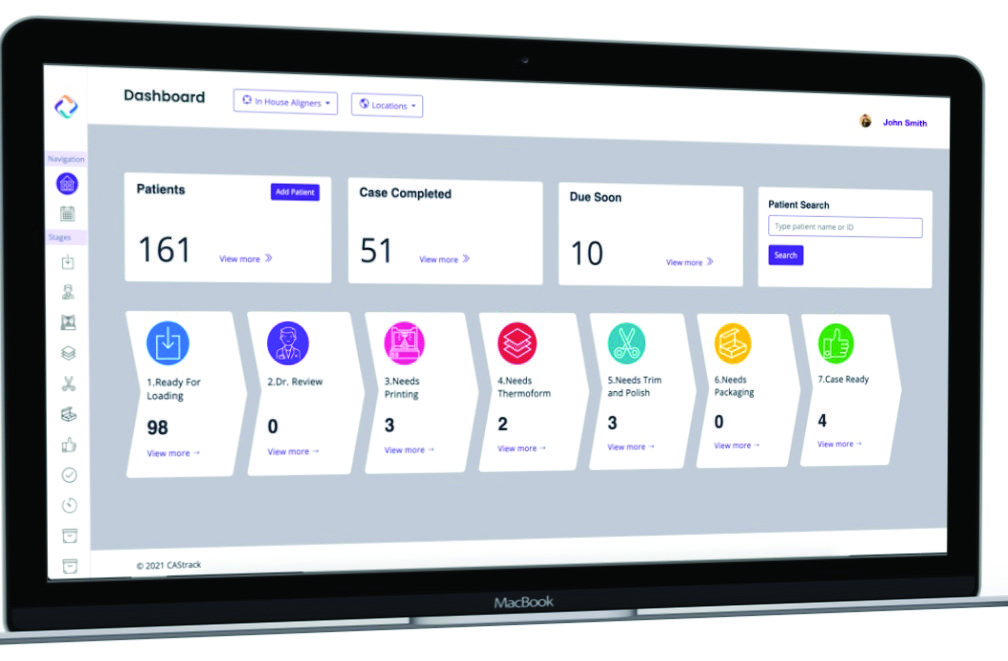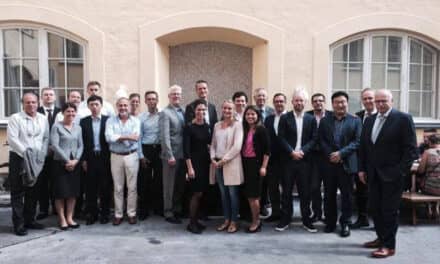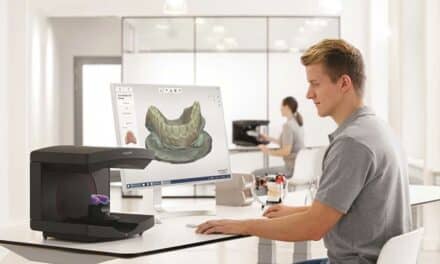Orthodontist Bryan Allen Lockhart, DDS, made the decision to treat all his aligner cases with in-office, 3D-printed aligners and in the process created new software to help orthodontists take the stress out of tracking and managing a ramped up in-office, 3D-printed aligner production.
Like many orthodontists in private practice, Bryan Allen Lockhart, DDS, of Dual Image Orthodontics in Charlotte, NC, initially incorporated a 3D printer into his lab to print models to make retainers, all in an effort to simplify the office’s workflow for remakes. But once he and his staff were comfortable with the process of 3D printing and thermoforming plastic, they took the next step and started producing in-office aligners. Initially, Lockhart planned to focus on simple tooth moving cases—mild spacing and relapse cases. But as the industry changed with the influx of new companies to the aligner space in 2018, Lockhart grew frustrated with the business choices the companies were making. And with that, he made the decision to treat all of his clear aligner cases with in-office, 3D-printed aligners.
But in ramping up his 3D printing lab, he faced a hurdle: How to track and manage each case and each step of the aligner fabrication process. Lockhart, who opened his first practice from scratch in 2015 with his wife and fellow orthodontist Lauren Rennick Lockhart, DDS, decided to find a solution and in the process developed his own software, CAStrack.
Orthodontic Products spoke to Lockhart not only to find out about his 3D printing lab setup, including the equipment and staffing, but also about the journey to creating CAStrack and becoming an entrepreneur. Lockhart, who more recently opened a second location as a joint practice with his wife’s twin sister who is a general dentist, talks about how the web-based, fully customizable CAStrack software can help the in-office 3D printing lab track all aspects of the aligner fabrication process to ensure cases are ready on time, while also reducing staff stress and creating a better customer experience. He also explains how CAStrack can be used to track and manage other in-house lab production processes and commercial digital orthodontic appliances production.



When Lockhart renovated his practice, he created a dedicated 3D lab that includes two separate, but adjacent, rooms—one dedicated to 3D printing (Figure 1 and 2) and the other to aligner fabrication (Figure 3).
Orthodontic Products: What’s your 3D printing lab setup?
Bryan Allan Lockhart, DDS: We recently (1.5 years ago) renovated our office space to make a dedicated 3D lab. It’s not necessary in most cases, but we were expanding our office space and decided to incorporate it at that time. We were printing in our breakroom for the first 2 years without any real issues.
Currently, we have two separate rooms that are adjacent to each other that have different purposes. One room is dedicated to 3D printing. In that room we have three 3D printers (EnvisionTec One, EnvisionTec Vida, SprintRay Pro), SprintRay Pro Wash, and three Cureboxes. We have a computer dedicated to tooth movement software and label printing. We also have an aligner trimming machine from 5axismaker. In the room next to the 3D printing room, we have our aligner fabrication room where we thermoform the aligners, trim, and polish them. We have two Drufomats and a polishing Dremel to polish the aligners.
We have a dedicated digital assistant who prints and makes all of our aligners. She is also responsible for case submissions of all of our digital treatment plans. I used to use a ‘divide and conquer’ strategy where I had multiple assistants handle certain aspects of the fabrication process out of fear that using one person would cause burnout. The issue became that they all got really good at their particular part and were not able to do other aspects when a team member was out sick or on vacation. Also, with that approach, there wasn’t one particular person who took accountability for the overall process. I’ve since moved to the digital assistant model where one person is in charge of the entire process and it has worked out beautifully for us.
OP: Why was 3D printing aligners in-office so attractive to you?
Lockhart: The cost savings is what most attracted me to in-office fabrication of aligners. Our overhead on our clear aligner cases was cut by 60% which is dramatic. In addition, there isn’t a quota that I have to maintain which removes the pressures of recommending certain appliances to keep up. However, what I overlooked was the control aspect of the process. I have complete control over when a case will be ready. If I need to turn around a case in a day because my patient is leaving to go abroad for 6 months, I can do it. If I remove an appliance and I need to have the aligners sooner to prevent teeth from shifting back, I can make it happen. The ability to control not only the turnaround time, but also the number of aligners needed is a big plus as well. Lastly, I don’t have to worry about companies changing policies to benefit them and not consider me. I have all of the say-so when it comes to the care that I deliver to my patients.
OP: Once you really started going, were there any unanticipated issues that popped up?
Lockhart: Once I started doing the simple cases, I realized that I could get great results. The anxiety of the unknown was removed and I really opened up to doing more cases. What I didn’t know was that it would be a total headache to track and manage all of the cases.
At the beginning, it wasn’t a big deal because our patient volume wasn’t huge. We started off using a whiteboard in the breakroom. But as patient volume increased, I moved on to using Excel spreadsheets so that I could access it on multiple computers, but it still wasn’t enough. I then tried commercial software that was mainly used for other orthodontic appliances, but had some functionality to help manage the in-office cases. But it also wasn’t enough to track and manage all of the cases. We still had the issue of cases not being ready in time and it really stressed everyone out and created a poor customer experience. None of the software was dynamic enough to allow me to know where each case was in production at any given time.
OP: To deal with the problem, you actually created a software to help you track and manage each case and each step of the aligner fabrication process—CAStrack. What does CAStrack do that the other dental software products and task management apps can’t?
Lockhart: I had to make a decision on whether to limit the number of cases to keep things manageable or figure out a way to make things work. I chose the latter, and CAStrack was born. CAStrack is a software that was built from scratch with the sole purpose to create a software that will make it extremely easy and efficient to track and manage our in-office aligner cases. It’s not a software that is being whitelabeled to do something that it wasn’t intended for. It’s also designed by an orthodontist (me). Because of that, I know all of the pain points that us orthodontists struggled with. CAStrack is built on simplicity, but is extremely detailed. With CAStrack, which is web-based, you are able to track where each case is along the fabrication process, which materials were used, type of case it is, and the number of aligners for the case. It allows for multiple sets/refinements to be managed for each patient. You’ll know exactly when the patients are due to come in and which cases to prioritize. Multiple users with separate logins can be created so that all activity can be tracked. Team members can then be held accountable for their actions. There are other software options that have bits and pieces of this functionality, but there isn’t another software that has all of those elements in one platform.

OP: Does CAStrack allow users to customize some of the workflow to work for their office?
Lockart: The beauty of CAStrack is that it is fully customizable. Templates come standard to act as a guide, but each office can manipulate it to fit their needs. One of the many frustrations I had with other software was that I had to fit my way of thinking into an existing preset system and that wasn’t the ideal fit. With CAStrack the user chooses the number of categories, what to name those categories, the category icons, and category colors. Offices are able to input the type of materials that they use and treatment planning software. CAStrack is fully customizable to each individual office so there’s no need to find work-arounds.
OP: Can CAStrack be used to track other 3D printing processes in the in-office lab—like models, retainers, or other orthodontic appliances?
Lockhart: The original goal of CAStrack was to manage and organize in-office aligner cases. Due to its flexibility and customization, I realized that it could also be used to manage and track other digital processes. With the profession moving in a more digital direction, there is a developing need to be able to organize it all. Offices can track and manage other commercial aligner companies such as Invisalign, Spark, and 3M. Other uses are retainer club subscriptions; LightForce, InBrace, and Stride braces; and other digital systems. Just another added value.
OP: It sounds like CAStrack is really about providing a global view of the appliances making their way from prescription to patient delivery in the practice and then allowing staff to drill down to see where each appliance is in the production chain and then manage those tasks to move it towards delivery.
Lockart: This is a big part of the magic. Knowing where each case is along the fabrication process is huge. The “due soon” section and the calendar view will identify and help prioritize which cases need the most attention. In addition to knowing which cases are next up, it’s extremely important to know if the case is at the beginning of the fabrication cycle or at the end. There aren’t any other companies that can provide this level of detail.
OP: What kind of training and customer support is available for users?
Lockhart: Offices are onboarded with a support team member to navigate the software, but also do a thorough walk through of the settings to set up the individual office preferences. There will also be a library of video demonstrations of some commonly asked questions.
OP: How has the software impacted your 3D printing lab and your overall practice efficiency and productivity? What was the most significant change that you have noticed?
Lockart: The biggest impact that CAStrack has had on our office is the stress relief. It has allowed our office to function and operate as smoothly as it ever has before. That has translated into us having cases ready to go in a timely manner which ultimately leads to better customer service and patient experience. It has also systematized our workflow which makes plugging in new team members seamless.
OP: How was the experience of creating the software? Have you done something like this before?
Lockhart: This was extremely exciting. The biggest push for me to create this was how badly I needed a software like CAStrack. I’ve never done anything like this before, but I was determined to make it happen. I didn’t know where to start. I prototyped it with a simplified version to serve as a proof of concept. Once I saw the power of it, I decided to hire a commercial software development company to take it to the next level. A lot of resources in the form of money, time, and meetings went into its development, but it was totally worth it. There was a ton of revamping and upgrades to get it where it is today.
OP: What has the experience of being an entrepreneur and starting your own business been like?
Lockhart: It has been a fun ride for sure, but it’s only the beginning. We have so many ideas that we are excited to bring to our users. To create technology that will benefit the profession is what is the most special. There is still a lot for me to learn, but I have the drive and desire to do what it takes to make it happen.
OP: What do you see for the future of CAStrack?
Lockart: I see CAStrack as the digital orthodontic management hub. I envision a dashboard that is integrated and synced to all of the digital orthodontic companies to house everything in one centralized location. No more 15 different web browsers to open daily.
OP: What’s your advice to someone thinking about incorporating 3D printing into their practice? Where should they start?
Lockhart: I tell orthodontists all the time that they should own a 3D printer. The cost of the printers has gone down significantly, but the technology has gotten better. The printers will pay for themselves with retainers alone. Start simple with retainers to master the 3D printing workflow and then the sky’s the limit from there. OP










